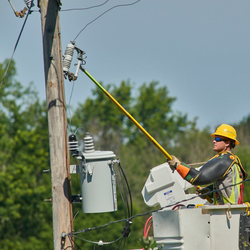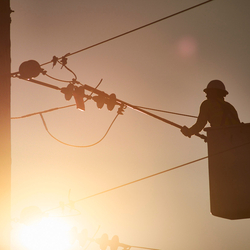From Overhead to Underground
How can we increase electric reliability, provide additional safety measures for humans and animals, and support a community’s economic development? By burying electric lines.
One of the most common causes of power outages and restoration delays is weather. Buried power lines are protected from lightning, high winds, tornadoes, heavy snow, ice and falling tree limbs. With fewer overhead lines to repair after storms, crews can respond faster to other outage areas, leading to improved emergency preparedness.
“We can’t control the weather, but we can control how we prepare for more extreme storms,” said Chris Laird, Consumers Energy Vice President of Electric Operations. “Burying the lines is just one tool we can use in our growing toolbox to prevent outages from impacting our customers.” As trees are another leading cause of power loss, our forestry team uses a variety of vegetation management methods to care for trees and your power. Moving below ground reduces tree trimming and makes room for more or larger trees. The improved aesthetics and reliability can lead to the attraction of new businesses or homeowners to an area.
Reducing wear and tear from weather and tree impacts by shielding lines underground lowers maintenance costs. Furthermore, maintenance can be coordinated with road repair activity (when applicable) to reduce excavation costs.
 Out of sight – out of reach! When they can no longer be damaged by wildlife and humans, power lines are less likely to need repair. Buried electrical equipment improves public safety and saves wildlife by reducing or eliminating downed wire electrocutions, fire hazards, vehicle collisions, falling poles, entanglement hazards (drones and low flying aircraft), vandalism, theft, illegal connections and sabotage.
Out of sight – out of reach! When they can no longer be damaged by wildlife and humans, power lines are less likely to need repair. Buried electrical equipment improves public safety and saves wildlife by reducing or eliminating downed wire electrocutions, fire hazards, vehicle collisions, falling poles, entanglement hazards (drones and low flying aircraft), vandalism, theft, illegal connections and sabotage.
While underground lines are less prone to damage, when there are issues it can take a bit longer to repair them. Yet, based on results from other energy providers that have moved overhead lines underground, we estimate that we can improve resiliency 90 percent along circuits where lines are buried.
It’s no surprise that work to bury electricity is gaining momentum as part of our continued focus on strengthening Michigan’s power grid.
Working to ensure future reliability from coal to clean energy includes determining how to best deliver the energy to you. With approval from the Michigan Public Service Commission (MPSC), our targeted undergrounding pilot program will help us better understand the most cost-effective way to bury lines. This pilot studies real-world resiliency and improvements that result from burying electric lines compared to other approaches for nearly 2 million Michigan homes and businesses. Circuits targeted in the pilot have frequent, lengthy outages with dense trees in areas of Genesee, Livingston, Allegan, Ottawa, Montcalm, and Iosco counties.
What does the future of moving overhead lines underground look like? After thoroughly evaluating where burying the higher voltage electric distribution between the poles will provide the most benefit, we’re aiming to underground about 400 miles of line annually. Neighborhoods will receive communications before, during and after construction to minimize impact, provide advance notice of any planned outages and restore property. This process begins with getting permission from various property owners for access to evaluate and perform the work.
Overhead power lines are moved underground and buried at least 24 inches deep. Depending on the project, this includes converting the primary and/or secondary electrical system but does not move the service wires attached to your home or business underground. If you are interested in paying to convert your property’s service wires, contact 800-477-5050. In some instances, poles will be removed while others will remain in place if they are owned or used by other services (cable, telecom, fiber).During construction, crews will be in the area, there may be lane closures and equipment along roadways or on your property. Similar to other reliability and resiliency projects, recovery of costs spread out among all customers goes through a rigorous approval process through the MPSC that ensures practical investments.
Regardless of whether your area is underground or overhead, always dig safe! It is the law for you to contact MISS DIG at least 3 days before any digging project. (This includes even routine jobs, such as planting shrubs and trees, replacing a mailbox post or installing a fence, deck or a basketball pole!) Call 8-1-1 or fill out the online form at MISSDIG811.org to have electric and natural gas facilities marked. This free service marks lines with stakes, flags or paint. Within 4 inches of the markings, hand dig to avoid causing damage, outages or injury to yourself.
Even if you don’t think there is damage, if you hit or nick a line, stop and call us immediately at 800-477-5050. If you see someone digging without markings and believe facilities exist below ground, contact MISS DIG to place a Concerned Caller Ticket.
Always plan ahead to dig safely and plant responsibly – away from overhead and underground facilities to ensure your vegetation reaches its full potential, without risking future interruptions to your services.
How do you decide what lines to move underground first? It’s important to convert from overhead strategically so that we bring the most value to customers. In each location, we evaluate whether the cost to bury lines and fix outages below ground is greater than overhead maintenance costs. While the underground cost per mile is now equivalent to above-ground costs, the pilot program will help us learn even more about how to bury facilities in ways that keep costs as low as possible. The increased frequency of severe weather during the last few years has also made undergrounding more appealing and cost effective. With all this in mind, we strategically evaluate:
- Outage history: those of frequent or long duration and causes.
- Constructability: assessments on obstructions, materials, and cost.
- Tree density: environmental impact and tree trimming maintenance.
- Quantity of customers served.
- Electrical load required and anticipated growth of the area.
- Other planned area projects that we could partner with in parallel to limit disruption.
Today, about 15 percent of our lines are underground, and most are located in subdivisions and areas with high population density. Unfortunately, it will never be feasible to put all wires below ground.
“It is important to remember burying our lines might be the right solution for some areas but not others. We will use a strategic approach and do it in the most cost-effective way for our customers. And by using a few different strategies to strengthen the grid, we will be able to deliver a brighter future for all the communities we serve,” said Greg Salisbury, Consumers Energy Vice President of Electric Distribution Engineering.
 With power underground, will there still be outages? While it will certainly help protect service during storms, the underground lines ultimately connect to areas above ground that could cause an outage. In addition, just like any other infrastructure, there is a natural lifespan for the equipment below ground so it will require repairs and maintenance. To avoid outages from digging damages, before starting a project, remember that it is the law to call 8-1-1 or visit missdig811.org for underground lines to be marked. Dig safely!
With power underground, will there still be outages? While it will certainly help protect service during storms, the underground lines ultimately connect to areas above ground that could cause an outage. In addition, just like any other infrastructure, there is a natural lifespan for the equipment below ground so it will require repairs and maintenance. To avoid outages from digging damages, before starting a project, remember that it is the law to call 8-1-1 or visit missdig811.org for underground lines to be marked. Dig safely!
As Michigan’s largest energy provider, we know our number one job is to keep the lights on for customers. We are committed to delivering more reliable, resilient, clean and affordable energy for every customer 24/7. To fulfill our commitment, we’re exploring different methods to improve the resiliency of the grid, including putting power lines underground where it is feasible and beneficial to do so.
Our overall $5.4 billion electric reliability plan is a blueprint for serving Michigan today while investing and innovating to meet the challenges of tomorrow. Investments are being made to install new technology and automation, trim trees, replace aging equipment and upgrade key equipment such as substations.
Undergrounding is one of several tactics we are employing to improve electric service for customers and to help us reach our reliability goals of:
- No event impacting more than 100,000 customers.
- All customers are restored within 24 hours.
- No customer will have more than 3 outages per year.
Our goals reflect our commitment and pride in serving 6.7 million of the state’s 10 million residents with electricity and/or natural gas in all 68 Lower Peninsula counties.
We look forward to continuing to implement superior technologies to reduce the frequency and duration of outages throughout Michigan. We’ll keep you updated as plans progress.